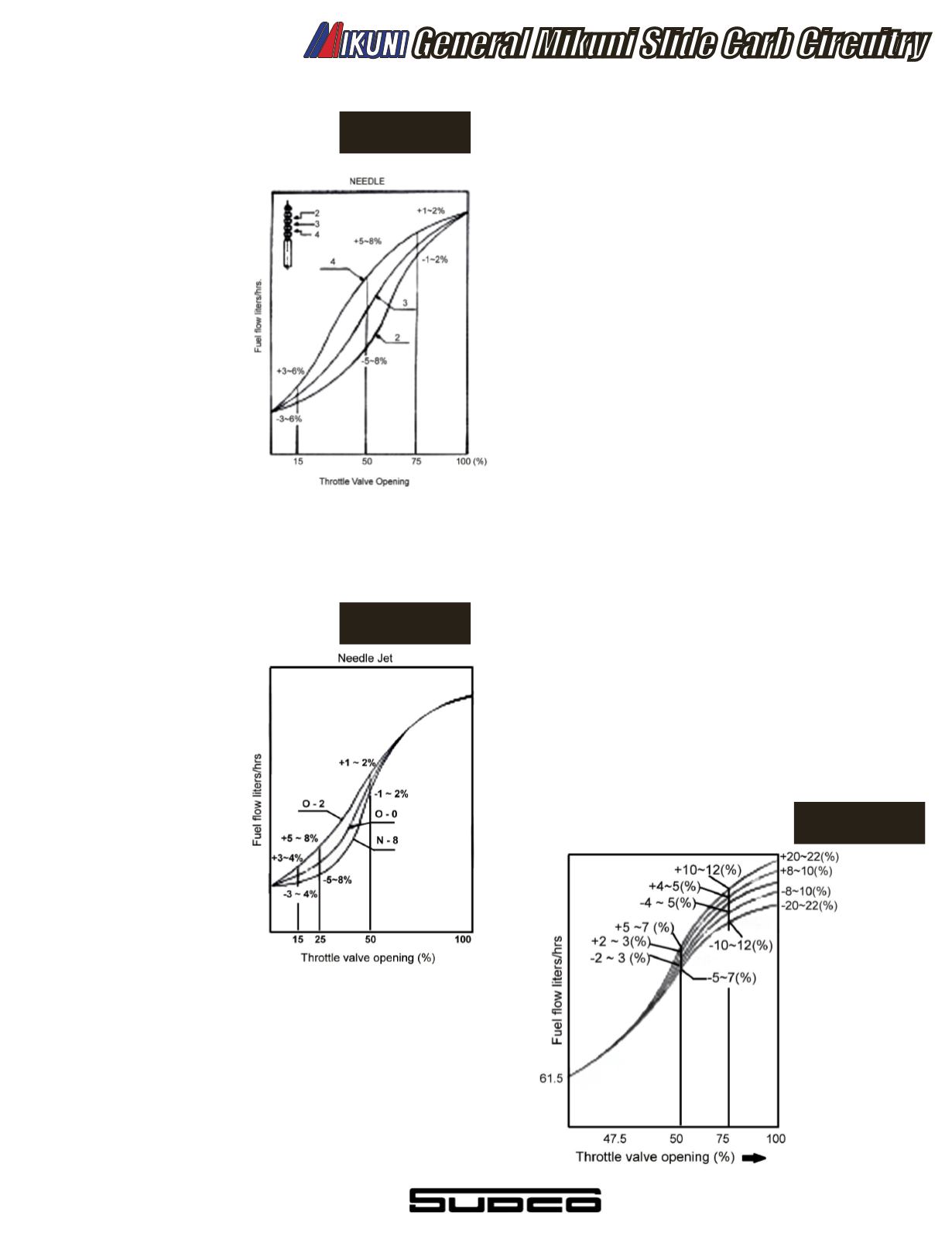

C- Selection of NEEDLE
(Fig. 13 & 14)
A carburetor
with a piston -type throt-
tle valve is also called
a variable venturi-type
carburetor. In this type
of carburetor, the needle
jet and the needle serve
to control a proper air-
fuel mixture ratio during
the so-called medium
throttle valve opening
(between 1/4 and 3/4
opening). The right
combination of needle
jet and needle will have
a major bearing on the
engine performance
at partial load. The jet
needle tapers off at one
end and the clearance
between the needle and
the needle jet increases
as the throttle valve opening gets wider. The air -fuel mixture is controlled
by the height of the needle positioning clip that is inserted into one of the
ive slots provided in the head of the needle. The variation of fuel low
based on the height of the clip is shown in Fig. 13.
Generally, it is easier
to evaluate and select
a needle jet than it is to
select a jet needle. The
reason is taht he needle
jet size are arranged
on a linear scale, with
each size increasing
in increments. (For
a thorough explana-
tion of needle jet sizes
please refer to Chapter
5) Jet needles are not
cataloged according to
a linear size pattern or
a rich lean scale. The
most effective way to
determine the needle
jet / jet needle relation-
ship is to visualize the
jet needle as a tool for
setting the fuel delivery
curve, or the it shape
of the fuel delivery ac-
cording to the throttle opening. The needle jet controls the fuel delivery
rate, either increasing or decreasing the fuel delivery according to the
proile of the needle being used. Sudco suggests that initially, experi
-
ments should be limited to changes in needle jet size. Once a satisfactory
size has been identiied, experiment with needle clip position to obtain
the best driveability and roll-on performance. if one is working with an
O.E.M. Mikuni carburetor, it is safe to assume that the manufacturer has
already selected the proper needle or “fuel curve” for that motorcycle and
changing the needle proile will complicate the tuning process Once the
correct needle jet size has been identiied and it becomes apparent that a
change in needle proile is necessary, then refer to the needle dimension
charts in Chapter 5.
To evaluate the performance of the needle jet, run the motorcycle
in the third
gear at 1/4 throttle, taking note on how the engine
accelerates from 1/4 to 1/2 throttle only. The engine should
respond cleanly and crispy without sputtering or bogging. It may
be useful to try experimenting with clip positions to decide if a
problem is a rich or lean condition. If the engine responses is
better at a lean clip position, it may be necessary to change
to a leaner needle jet. Sudco suggests that it is best to use as
lean a needle jet as possible, as this component will have the
greatest effect on fuel economy, emission, and general driveability.
If a leaner needle jet is installed and there is no negative impact on
performance, and no positive effect, continue working in the
direction of “lean” until there are negative results and go back up
one size.
D. - Selection of the Main Jet
First, do the following on a lat road.
1)
Select the largest main jet ( the limit of a rich mixture) which
can give you the maximum speed). In this case, select the engine
speed according to the dimensions of the test course.
2)
Compare the gain in speed of 25-30 MPH to maximum
desired speed, by using different sizes of main jets.
3)
Check the exhaust fumes and read the spark plug (selection
of the spark plug should be made based on the thermal value
that would best suit power output of the engine.
Next, compare in the racing course, the test results you
obtained from above. The points to be checked, among others, are:
1)
Smooth and steady operation of the engine at as high a
speed as possible under varying operating conditions
such as shifting of the gears, changes in road conditions,
ascending and descending slopes, etc.
2)
Sustained operation at low speeds and at heavy engine load.
3)
Sustained operation at high speeds (without knocking or seizure).
CAUTIONS:
Selection of too lean amain jet may cause
severe engine overheating, and subsequent piston seizure.
Fig. 12 shows comparison of fuel low curves. The straight
line is for Model C main jet and the dotted line for Model A
and B main jets. In each model of main jet, different sizes
within the range of +10% were tried.
General Mikuni Slide Carb Circuitry
Figure 17
Figure 14
Figure 12
541
















